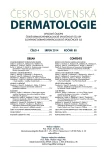Our first Experiences with Infections Caused by Arthroderma benhamiae (Trichophyton sp.)
Authors:
M. Skořepová 1; V. Hubka 2,3; S. Polášková 1; J. Stará 1; A. Čmoková 2
Authors‘ workplace:
Dermatovenerologická klinika 1. lékařské fakulty Univerzity Karlovy a Všeobecné fakultní nemocnice v Praze
přednosta prof. MUDr. Jiří Štork, CSc.
1; Katedra botaniky, Přírodovědecká fakulta, Univerzita Karlova v Praze
vedoucí doc. RNDr. Yvonne Němcová, Ph. D.
2; Laboratoř genetiky a metabolismu hub, Mikrobiologický ústav, Akademie věd České republiky, v. v. i., Praha
vedoucí Mgr. Miroslav Kolařík, Ph. D.
3
Published in:
Čes-slov Derm, 89, 2014, No. 4, p. 192-198
Category:
Case Reports
Overview
Trichophyton sp. anamorph of Arthroderma benhamiae is an emerging agent of dermatophytoses. During the period from 1. 1. 2012 to 31. 12. 2013 this zoophilic dermatophyte was isolated from 25 patients in the laboratory of the Clinic of Dermatology and Venereology. The identification of the species was confirmed by molecular methods. Clinical data and therapeutic outcome were available for 15 patients, 12 of them were children aged 2–10 years, only 3 were adults. Guinea pigs were the source of the infection in 9 cases, other rodents in 2 cases. In 3 cases infection from a dog was also possible. The incubation period ranged from 3 to 4 weeks. The clinical appearance of the lesions showed no particular difference from other infections by zoophilic dermatophytes, with the exception of green fluorescence in Wood’s light which is otherwise characteristic for Microsporum (not Trichophyton) lesions. Naftifine or ciclopiroxolamine were effective in topical therapy of the lesions on the glabrous skin, whereas topical clotrimazole was ineffective. Scalp lesions healed after 4–8 weeks of oral terbinafine.
Key words:
dermatophytoses – Arthroderma benhamiae – diagnosis – therapy
Sources
1. BRAUN, S., JAHN, K., WESTERMANN, A., BRUCHGERHARZ, D., REIFENBERGER, P. D. J. Tinea barbae profunda durch Arthroderma benhamiae. Hautarzt, 2013, 64, p. 720–722.
2. FRAGNER, P., HEJTMÁNEK, M. Určování dermatofytů. Olomouc: Univerzita Palackého v Olomouci, 1990, 190 p.
3. FUMEAUX, J., MOCK, M., NINET, B., et al. First report of Arthroderma benhamiae in Switzerland. Dermatology, 2004, 208, p. 244–250.
4. GRÄSER, Y., KUIJPERS, A. F. A., PRESBER, W., DE HOOG, G. S. Molecular taxonomy of Trichophyton mentagrophytes and T. tonsurans. Med. Mycol., 1999, 37, p. 315–330.
5. GRÄSER, Y., SCOTT, J., SUMMERBELL, R. The new species concept in dermatophytes – a polyphasic approach.
Mycopathologia, 2008, 166, p. 239–256.
6. HEJTMÁNEK, M., HEJTMÁNKOVÁ, N. Hybridization and sexual stimulation in Trichophyton mentagrophytes. Folia Microbiol., 1989, 34, p. 77–79.
7. HUBKA, V., KOLAŘÍK, M. ß-tubulin paralogue tubC is frequently misidentified as the benA gene in Aspergillus section Nigri taxonomy: primer specificity testing and taxonomic consequences. Persoonia, 2012, 29, p. 1–10.
8. HUBKA, V., KUBATOVA, A., MALLATOVA, N. et al. Rare and new aetiological agents revealed among 178 clinical Aspergillus strains obtained from Czech patients and characterised by molecular sequencing. Med. Mycol., 2012, 50, p. 601–610.
9. KANO, R., NAKAMURA, Y., YASUDA, K., et al. The first isolation of Arthroderma benhamiae in Japan. Microbiol. Immunol., 1998, 42, p. 575–578.
10. KAWASAKI, M., ASO, M., INOUE, T., et al. Two cases of tinea corporis by infection from a rabbit with Arthroderma benhamiae. Jap. J. Med. Mycol., 1999, 41, p. 263–267.
11. KAWASAKI, M., ANZAWA, K., TAKEDA, K., et al. Genetic and phenotypic variations among F1 progenies of Arthroderma benhamiae. Jap. J. Med. Mycol., 2008, 49, p. 103–110.
12. KRAEMER, A., HEIN, J., HEUSINGER, A., MUELLER, R. Clinical signs, therapy and zoonotic risk of pet guinea pigs with dermatophytosis. Mycoses, 2013, 56, p. 168–172.
13. MAYSER, P., BUDIHARDJA, D. A simple and rapid method to differentiate Arthroderma benhamiae from Microsporum canis. J. Dtsch. Dermatol. Ges., 2013, 11, p. 322–327.
14. NENOFF, P., HERRMANN, J., GRÄSER, Y. Trichophyton mentagrophytes sive interdigitale? A dermatophyte in the course of time. J. Dtsch. Dermatol. Ges., 2007, 5, p. 198–202.
15. NENOFF, P., SCHULZE, I., UHRLASS, S., KRÜGER, C. Kerion Celsi durch den zoophilen Dermatophyten Trichophyton species von Arthroderma benhamiae bei einem Kind. Hautarzt, 2013, 64, p. 846–850.
16. SIEKLUCKI, U., OH, S. H., HOYER, L. L. Frequent isolation of Arthroderma benhamiae from dogs with dermatophytosis. Vet. Dermatol., 2014, 25, p. 39–41.
17. SYMOENS, F., JOUSSON, O., PLANARD, C., et al. Molecular analysis and mating behaviour of the Trichophyton mentagrophytes species complex. Int. J. Med. Microbiol., 2011, 301, p. 260–266.
18. SYMOENS, F., JOUSSON, O., PACKEU, A., et al. The dermatophyte species Arthroderma benhamiae: intraspecies variability and mating behaviour. J. Med. Microbiol., 2013, 62, p. 377–385.
19. TAKEDA, K., NISHIBU, A., ANZAWA, K., MOCHIZUKI, T. Molecular epidemiology of a major subgroup of Arthroderma benhamiae isolated in Japan by restriction fragment length polymorphism analysis of the nontranscribed spacer region of ribosomal RNA gene. Jpn. J. Infect. Dis., 2012, 65, p. 233–239.
Labels
Dermatology & STDs Paediatric dermatology & STDsArticle was published in
Czech-Slovak Dermatology

2014 Issue 4
Most read in this issue
- Our first Experiences with Infections Caused by Arthroderma benhamiae (Trichophyton sp.)
- A Case of Tinea Corporis caused by Microsporum Incurvatum – a Geophillic Species related to M. gypseum
- Arthroderma benhamiae as a Causative Agent of Tinea Capitis Profunda nad Tinea Corporis in Children
- Recent Advances in Taxonomy of Dermatophytes and Recommendations for Using Names of Clinically Important Species
